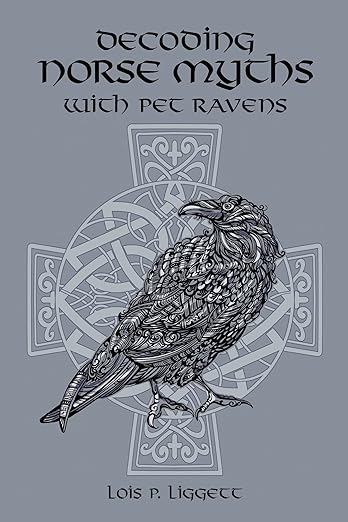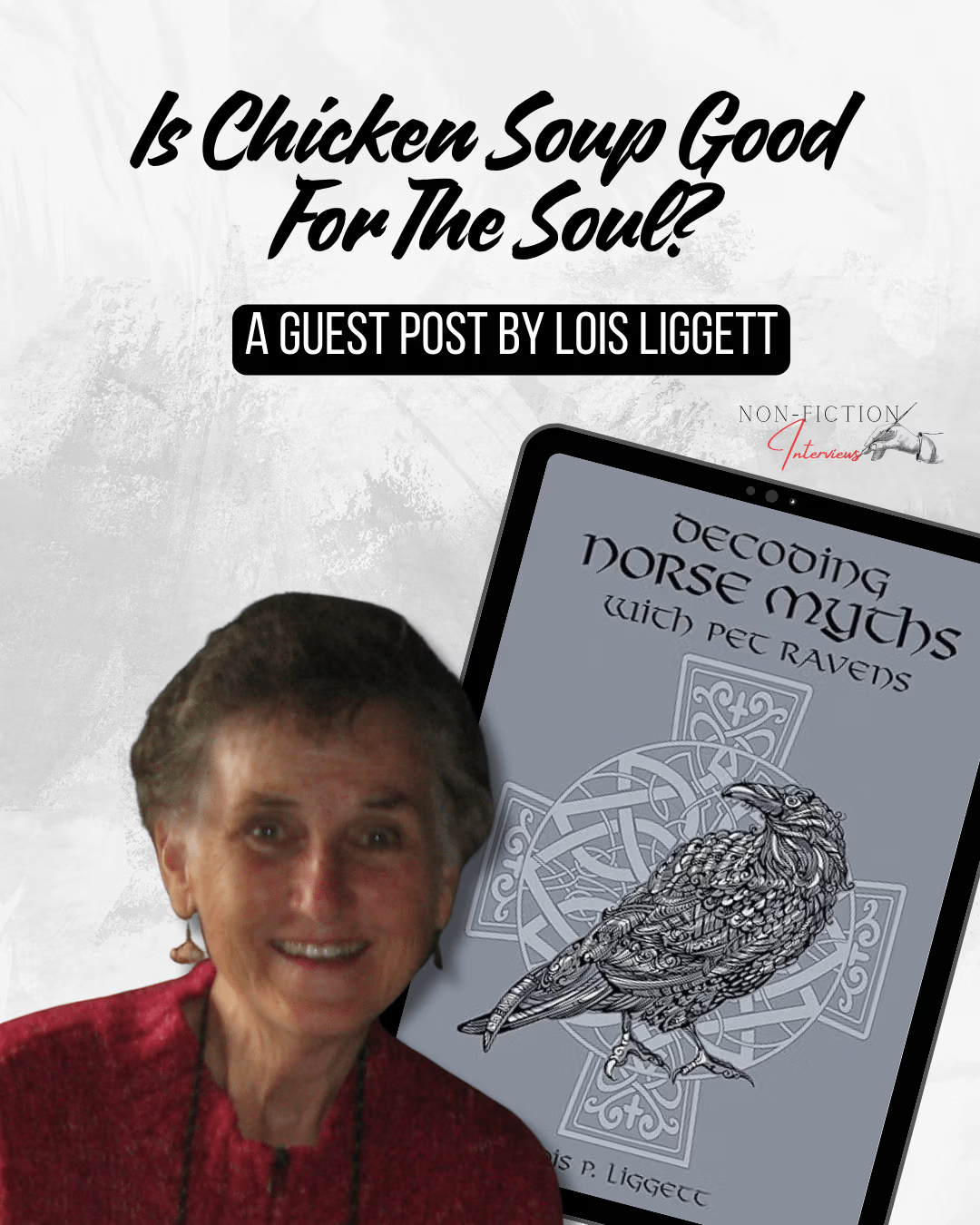This is an excerpt, plucked and pulled from The ROOTED TONGUE, an unpublished 1800-page word commentary by Lois Liggett.
Is chicken soup good for the soul and good for healing what ails you? The etymology and definitions related to this phrase suggests this is so!
This excerpt begins with fowl. Derivations are: ME fugel, fowel, foule and foghel; OE fugol; OFris fugel; OS fugal; OHG fogal; Goth fugls; Ger vogel meaning bird; Gmc fuglaz, flugluglaz, flug, and fleug; and IE base pleu with link to IE pleus. IE base pleu basically means to flow, yielding words and meanings of: to rain; plover; pulmonary; lung; pneumonia; Pluto; to fly; arrow; feather; flight; flutter; fluster; flue; flood; and liquor (from OIr linn). IE pleus means to pluck, fleece, and plume. Definitions are: any bird; any of various domestic birds used as food, as chicken, duck, goose, turkey, pheasant, quail, and peafowl; a full-grown chicken, as distinguished from a springer; the flesh of any of these birds used for food; and to catch, trap, hunt, or shoot wild birds for food or sport.
Chicken is derived from: OE cycen and cicen; WGmc kiukina and kiuk; MLowG kuken; MHG kuchelin; Du kuiken and kieken; MDu cuken and kieken; and ON kiuklingr. Some of these derivations also yield cock. Chicken is defined as: a common gallinaceous farm bird raised for its edible eggs or flesh; hen or rooster; the meat of this bird; any young bird, as in chick; a young inexperienced person; a timid or cowardly person; a young male homosexual; petty insistence on rules; and small and tender. A chicken pecks at the ground to find even the pettiest of food grains.
Hen is derived from: OE henn and haen; OE hana meaning cock; Ger hahn; OHG henna and heninna; MHG hennel; OHG hano; MHG hane and han; OFris and Goth hana; ON hani; L canere meaning to sing; Grk eikanos meaning cock literally meaning singing in the dawn; and IE base kan meaning to sing. Hen refers to the female of the domesticated chicken, the female of other kinds of birds and certain other animals (as the lobster), and the slang for an older woman. These definitions show where the phrase, “hen-pecked husband” originated.
Scot hen is defined as: a term of address applied to a woman or girl; a term of endearment for a wife; to break a bargain; withdraw from an engagement. Scot hen-bird refers to a hen or a chicken following its mother. Scot hen broth refers to chicken broth. Scot hen’s care means care exercised without judgment. Scot henmaist means last or hindmost. Scot hensure means a giddy young fellow.
The hen is very protective of her brood. In mythology and fairy tales the hen has laid the golden egg, and warns of the sky falling. The hen is mentioned in Matthew 23:37 of the Biblical New Testament: “O Jerusalem, Jerusalem, you who kill the prophets and stone those sent to you, how often I have longed to gather your children together, as a hen gathers her chicks under her wing…”
Chickens are poultry. Poultry is derived from: ME pultrie; MFr pouleterie and poulet, and poule meaning hen; L pullus meaning chicken and small farm animal; L puer meaning child; and IE base pou or pu meaning small child or small animal and yielding foal and few. The definition is domestic fowls raised for meat or eggs. A poult is any young fowl. Pullet, derived from ME poullet and OFr poulet and poule meaning hen, refers to a young hen, less than a year old. Pullulate, derived from L pullulare meaning to spread out and sprout and L pullus, is defined as: to sprout out; germinate; bud; to breed quickly; to spring up in abundance; and teem or swarm. Is pull related?
Some of the derivations and definitions imply this link. Pull, derived from ME pullen, OE pulliam meaning to pluck or snatch with fingers, and MHG pull meaning husk and shell, has a few related definitions such as to pluck out, to pick or uproot (feathers have roots), and to draw the entrails from. Another definition, to pull apart because of a fault, can link foul with fowl. A foul is considered a fault. Fowl, foul, and pollution can be linked. Under polluted conditions, thus foul conditions, bird flu may be prevalent. chickens are sometimes found in “cooped up” conditions leading to a polluted environment and bird flu. What is the stir about “free range” chickens? What happens to people in “cooped up” conditions, especially in an uncooperative society and what is the role of politics?
How did the idea that chicken soup, good medicine for the flu, get started? Note IE base pleu given as root for fowl yields flue. Both flu and flue share the idea of flow. When a person has the flu the breathing passages may be blocked. The ill person may use a poultice for drawing or pulling out the fever, or sip chicken soup. Flu is short for influenza. Influenza, from It influenza meaning influence (because astrologers attributed the malady to the influence of the stars), is defined as: an acute, contagious, infectious disease, caused by any of a specific group of viruses and characterized by inflammation of the respiratory tract, fever, and muscular pain; and any of various virus diseases of domestic animals, characterized by inflammation of the respiratory tract.
Poultice, also spelled pultes, is derived from: ML poultice meaning thick pap with L puls meaning pulse. Poultice is defined as: a hot, soft, moist mass, as of flour, herbs, and mustard, sometimes spread on a cloth, and applied to a sore or inflamed part of the body. Pap is soft food or a reference to the nipple of the breast, which issues forth nourishment. When a person has a fever the pulse is faster than normal. However, the pulse, related directly to poultice is derived from: ME pous; OFr pouls; L puls or pultis meaning a pottage made with meal or pulse; Grk poltis; L pollen and pulvis; and IE base pel meaning dust and meal and yielding skin, to beat, pale; pallid; dispel; expel; dish or bowl; to fill; plenty; planet; and plaster. Hence, the high pulse due to the fever is repulsed back to normal after the poultice application. Appulse, from L appulsus meaning driven to or landed and L pellare meaning to drive or push, is defined as: an approach or impact of one moving body toward or upon another; energetic motion toward a point; of a heavenly body toward the meridian; the act of striking against; and in astrology, the approach or occurrence of conjunction between two celestial bodies. This latter word links astrology and influenza. In Egyptian mythology the paps of Nut, the goddess who overarches the heaven, feed the creation that lies below. She is akin to Mother of the night representing the darkened womb, who gives birth to the stars (the Milky Way), and who in Grk mythology laid the silver egg (possibly referring to the moon). Nut is also known as Isis and Hathor.
Plaster can be a type of poultice, defined as a pasty preparation spread on a cloth and applied to the body as a curative or counterirritant.
Soup, stock, and broth are made from the vital juices of vegetables, fish, fowl, and the meat from other animals. Broth is derived from: OE broth; MIr embruthe meaning broth and bruith meaning to boil; OIr broth meaning corn (whiskey); Corn bros; Welch broch meaning froth; Manx brott; Gael brot and broit meaning boiled; ON brauth meaning bread; Ger brodein meaning to bubble; L defrutum meaning must boiled down; Grk bruton meaning a fermented beer and linked to brew; and IE base bher. IE bher has meanings of: to ferment, well-up, seethe, brew, burn, boil, and bread. Broth is defined as: a clear, thin soup made by boiling meat, cereals, or vegetables in water. Scot broth can be used as a noun in the phrase “a broth of a sweat”, meaning a violent perspiration or to be in a state of perspiration.
One stock definition is something out of which other things are made, such as the water in which meat, fish, or vegetables have been boiled and used as a base for soup. stock is also a type of investment that can pay dividends. A contrary definition is based on the tree stump or the block signifying anything lacking life, motion, or feeling. A stockade is like a fortified place where stakes are driven into the ground for protection. -ade is a suffix defined as signifying the result or product of, a drink made from some substance (in this case a vegetable or meat stock), and participation in an action. The Grk word root ade means enough, abundantly, and to be filled (perhaps as an aid to becoming well after the flu).
Soup, derived from Fr soupe and IE base seu yielding sup, suck, and sip, is defined as: a liquid food, with or without solid particles, made by cooking meat, vegetables, or fish, in water, milk, and other liquids; and a heavy fog. Colloquialisms related to soup are: “from soup to nuts” meaning from beginning to end, or completely or exhaustively; “in the soup” means to be in trouble; and “soup up” means to increase power or capacity for speed. Gravy is the vital juice given off by meat in cooking, so gravy is linked to soup. Gravy maybe derived from ME grave meaning a name for cooking ingredients, and a possible misreading of OFr grané perhaps meaning grain. gravy can be “heavy”, as soup can be heavy, hearty, very warm, satisfying, strong and healthy, and nourishing and plentiful. Grains are seeds and akin to sap or juice as the source, origin, or beginning of anything. Sap is derived from IE base sap meaning to taste and perceive.
Broth is related to brother. Brothers in a fraternity or religious order, share from the same kettle of soup. L frater means brother, and it also refers to the eating room or refectory. Refect means to refresh with food or drink with refection derived from L reficere meaning to remake or restore. Bread may accompany soup. Brothers, as well as sisters, break bread together and share the pieces broken off from the whole loaf. Share basically means to divide with meanings of: a part or portion that belongs or is allotted to an individual; a just, due, reasonable, or full part or quota; give out a proportion; to receive, use, and experience in common with another or others; participate; and partake. Another meaning of share is a part of a plow or other agricultural tool that cuts the soil, as in plowshare. People managing soup kitchens feeding the hungry understand the idea of sharing.
Scot brother, as a verb, is defined as: to inure, accustom, often by rough usage; to initiate into a guild or citizenship, often by ludicrous means; inurement; rough usage; and exposure to rough weather. These meanings reflect the phrase of being “in the soup” meaning in trouble, or trouble is brewing. Brew definitions are: to make from malt and hops by steeping, boiling, and fermenting; to make tea, coffee, or other drink by steeping or boiling; to plan mischief or trouble; plot; scheme; and to begin to form, as in a storm or trouble. If a person is “hopping along” it can be taken as a sign of high energy, like a bubbly person.
Consumme is a clear soup made by boiling meat or vegetables in water and straining. The derivations, yielding consummate, are: L consummatus and consummare meaning to sum up or finish with com meaning together plus summa meaning sum or total; L super meaning above; and IE bases eghs and uper. IE base eghs yields meanings of out, from, external, and last. IE base uper means over, super, superior, excellent, and superb. Consummate is defined as: complete and perfect in every way; supreme; very skillful; highly expert; accomplish; and fulfillment. Yet one last type of soup can be mentioned, bouillon, a clear broth.
Bouillon, from Fr bouillir meaning boil, refers to a clear broth of soup, usually from beef. A bouillon cube is a small cube of concentrated stock for making bouillon. Through boiling the remnants of the animal the juices are concentrated and clarified or purified. One meaning of clarification is to make or become easier to understand. Clarify is linked to clear. Definitions of clear are: bright; clear-sounding; without blemish; easily heard or seen; sharply defined; distinct; certain; free from guilt or charge of guilt; innocent; net; free from debt; free from qualification; absolute; complete; free from contact; not entangled, confined, or hindered; free from obstruction; open; freed or emptied of freight or cargo; to decode or decipher; to pass or leap over; to be passed or approved by; to go through; to handle and deal with properly; to pass away; vanish; and a clear space.
Perhaps bullion is related. Gold bullion is pure. Broth and bouillon can be clear and golden.
Bullion has two sets of meanings. The first is derived from: OFr billon meaning a small coin of copper with silver with bille meaning a stick or bar and linked to billet; and possibly Du bulioen. This bullion refers to: gold and silver regarded as raw or elemental material; or gold or silver ingots, bars, or coins. The second bullion is probably linked to the first and derived from: Fr bouillon and bouille meaning a seal on silk goods; Sp bolla meaning duty on silk; and L bulla. This bullion refers to a heavy fringe or lace of twisted gold or silver thread.
Soul is derived from: ME soule; OE sawol; Ger seele; Goth saiwala; and Gmc saiwalo probably meaning belonging to the sea based on early Gmc belief that souls originate in and return to the sea. Five definitions given here are: an entity which is regarded as being the immortal or spiritual part of a person, and, though having no physical or material reality, is credited with the functions of thinking and willing, and hence determining all behavior; the moral or emotional nature of a human being; spiritual or emotional warmth or force, or evidence of this; vital or essential part, quality, or principle; and embodiment.
About the author, Lois Liggett
Decoding Norse Myths with Pet Ravens is Lois Liggett’s first book. Norse mythology has intrigued mythologists, linguists, and runologists for many decades. This intrigue lies in the mysteries that lurk in these myths. These mysteries include the lack of archeological finds prior to the Viking Age, (late 700s A.D. to 1100), the absence of authentic celebratory rituals paying homage to the Norse gods and goddesses, and an absence of a thorough explanation of the meaning of the names of the Norse gods and goddesses. This book sheds light on these mysterious elements, especially the meaning hiding beneath the names and places in Nordic myth. This commentary is a lexicon focused on etymology and semantics designed to allow the reader to gain insight into these myths.
Definitions linked to names of gods and goddesses and words found in the Norse myths become a lexicon referring to the vocabulary of a particular people, a language, and a branch of knowledge, that have application both in the present and the ancient past. I let the words journey me across the boundaries of time, culture, and academia. Follow the common threads of various languages related to similar words to discover the essential meanings. The written versions of Nordic myths and sagas from the oral tradition occurred in the 13th century by a small number of people. It seems to me that there is a margin of error in misinterpretation of sounds and images of these oral traditions when committed to written documents. This margin of error is part of the intrigue and mystery. The Norse myths may have been 100s, if not 1,000s of years old when Snorri Sturluson committed them to paper in the early 13th century.












